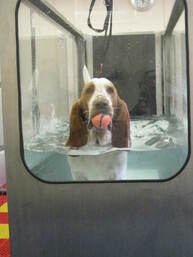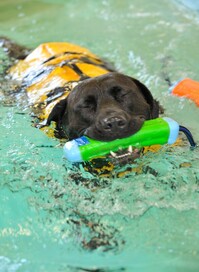YOU MAY ASK
Why Hydrotherapy?
Hydrotherapy is beneficial for the following conditions:
Hip and elbow dysplasia, spinal injuries and paralysis, osteochondritis dissecans (OCD), cruciate ligament problems, post-operative muscle regeneration and maintenance, sprains and breaks, relief of pain, swelling, arthritis, stiffness, obesity, weight management, improvement of circulation and joint mobility, general fitness and for when normal exercise is restricted.
Swimming is an excellent non-weight bearing exercise that avoids the stresses and strains of exercising on hard ground. It enables the joints to move with greater ease and increased range of movement, loosens tightened muscles and reduces pain and inflammation.
Any dog that is suffering from the conditions listed above will benefit from a controlled swimming activity. It will help strengthen muscles without risking further injury.
For dogs following surgery, hydrotherapy removes the weight loading on the injured limb and will enable the gradual rebuilding of wasted muscle. It reduces the pain and will accelerate recovery after surgery.
Hydrotherapy is also very useful for dogs scheduled to have orthopaedic surgery such as cruciate ligament repair. In such cases it helps to improve muscle tone in the limbs which will speed up the post-operative recovery.
Even ageing dogs can benefit from controlled swimming as the soothing effect of the warm water improves circulation and encourages increased mobility in sore, stiff and arthritic joints.
Swimming is also great exercise for healthy dogs to improve their cardiovascular fitness, muscle tone and general well-being.
As the health and safety of all dogs is paramount, owners must seek their vets approval before commencing hydrotherapy treatment, to ensure the dog does not have any underlying problems that may make hydrotherapy unsuitable and to give the vet an opportunity to bring any other medical problems to the therapist's attention.
All treatment programmes will be carefully designed to aid the dogs recovery. The dog can swim in a variety of controlled ways, free swimming in still water or with more resistance introduced through powerful, controllable water jets. Alternatively treatment in the underwater treadmill may be more appropriate.
Hydrotherapy is beneficial for the following conditions:
Hip and elbow dysplasia, spinal injuries and paralysis, osteochondritis dissecans (OCD), cruciate ligament problems, post-operative muscle regeneration and maintenance, sprains and breaks, relief of pain, swelling, arthritis, stiffness, obesity, weight management, improvement of circulation and joint mobility, general fitness and for when normal exercise is restricted.
Swimming is an excellent non-weight bearing exercise that avoids the stresses and strains of exercising on hard ground. It enables the joints to move with greater ease and increased range of movement, loosens tightened muscles and reduces pain and inflammation.
Any dog that is suffering from the conditions listed above will benefit from a controlled swimming activity. It will help strengthen muscles without risking further injury.
For dogs following surgery, hydrotherapy removes the weight loading on the injured limb and will enable the gradual rebuilding of wasted muscle. It reduces the pain and will accelerate recovery after surgery.
Hydrotherapy is also very useful for dogs scheduled to have orthopaedic surgery such as cruciate ligament repair. In such cases it helps to improve muscle tone in the limbs which will speed up the post-operative recovery.
Even ageing dogs can benefit from controlled swimming as the soothing effect of the warm water improves circulation and encourages increased mobility in sore, stiff and arthritic joints.
Swimming is also great exercise for healthy dogs to improve their cardiovascular fitness, muscle tone and general well-being.
As the health and safety of all dogs is paramount, owners must seek their vets approval before commencing hydrotherapy treatment, to ensure the dog does not have any underlying problems that may make hydrotherapy unsuitable and to give the vet an opportunity to bring any other medical problems to the therapist's attention.
All treatment programmes will be carefully designed to aid the dogs recovery. The dog can swim in a variety of controlled ways, free swimming in still water or with more resistance introduced through powerful, controllable water jets. Alternatively treatment in the underwater treadmill may be more appropriate.




